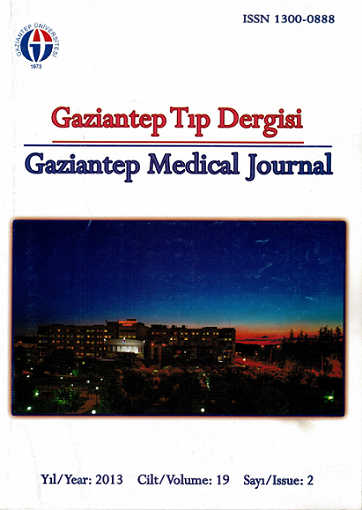Clinical, laboratory, and echocardiographic features of patients with pericardial effusion in Gaziantep region
Keywords:
Echocardiography, heart failure, infectious diseases, pericardial effusion, pericardiocentesisAbstract
Pericardial effusion (PE) is called that increase in the amount of fluid between the pericardium surrounding the heart. PE may be due to primary pericardial diseases, or associated with different clinical situations such as malignancy, chronic renal failure, cardiovascular diseases, infectious diseases. In our study, patients with PE present in the Gaziantep region to evaluate the clinical characteristics and treatment. 132 patients, having PE on transthoracic echocardiography, admitted to the cardiology clinic between January 2010 and January 2011, were retrospectively reviewed data. Background, echocardiography, laboratory findings, and treatment of the patients were recorded. The average age of the patients was 51 ± 17 (17-86) year. It was observed with equal frequency in males and females (66/66). The most common primary complaint of patients with PE were dispne(73.5%). Mild PE (<10 mm) on Echocardiography was the most common (48.5%). The most common causes of PE were a history of infectious diseases and heart failure. 21.2% of the patients underwent pericardiocentesis. The most common only NSAIDs in patients undergoing medical treatment (50%). Effusion disappeared pericardiocentesis, dialysis and medical treatment in 105 patients (79.5%). Medical treatment of PE, an average of 36 ± 39.2 (6-190) days disappeared. Four patients died during the follow-up regardless of the amount the effusion in the hospital. PE is developing in the process of many diseases. Of the patients in the outpatient treatment may be sufficient however, the etiology of PE is a major cause of prognosis in chronic disease cases accompanied by close monitoring of patients is important.
Metrics
References
Bıyık İ, Ergene O. Kronik Perikardiyal Efüzyonda Tanı ve Tedavi Yaklaşımı.Türk Kardiyol Dern Arş. 2004;32:581-590.
Maisch B, Seferovic PM, Ristic AD, Erbel R, Rienmüller R, Adler Y, et al; Task Force on the Diagnosis and Management of Pricardial Diseases of the European Society of Cardiology. Guidelines on the diagnosis and management of pericardial diseases executive summary; The Task force on the diagnosis and management of pericardial diseases of the European society of cardiology. Eur Heart J. 2004;25:587-610.
Allan LK, Craig RA: Diseases of thepericardium, restrictivecardiomyopathyanddiastolicdisfunction. Topol EJ(ed). Textbook of CardiovascularMedicine. Philadelphia, Lippincott Williams Wilkins. 2002:614-616.
Gümrükçüoğlu HA, Akyol A, Tuncer M, Güneş Y, Beğenik H, Akdağ S, et al. Perikart efüzyonu olan hastaların klinik ve laboratuvar özellikleri. Türk Kardiyol Dern Ars. 2010;38:473-479.
Seferovic PM, Ristic AD, Maksimovic R, Simeunovic DS, Milinkovic I, et al. Pericardial syndromes: an update after the ESC guidelines 2004. Heart Fail Rev. 2012. [Baskıda]
Pawlak Cieslik A, Szturmowicz M, Fijałkowska A, Gatarek J, Gralec R, Błasinska Przerwa K, et al. Diagnosis of malignant pericarditis: a single centre experience. Kardiol Pol. 2012;70:1147-1153.
Maisch B, Ristic A, Pankuweit S. Evaluation and management of pericardial effusion in patients with neoplastic disease. Prog Cardiovasc Dis. 2010;53:157-163.
Becit N, Unlü Y, Ceviz M, Koçogullari CU, Koçak H, Gürlertop Y. Subxiphoid pericardiostomy in the management of pericardial effusions: case series analysis of 368 patients. Heart. 2005;91:785-790.
Markovic NS, Dimkovic N, Damjanovic T, Loncar G, Brajovic M, Dimkovic S. Correlation between the inferior vena cava collapsibility and asymptomatic pericardial effusion in hemodialysis patients. Med Pregl. 2007;60 Suppl 2:165-169.
Mathenge RN, McLigeyo SO, Muita AK, Otieno LS. The spectrum of echocardiographic findings in chronic renal failure. East Afr Med J. 1993;70:107-111.
Yu SB, Zhao QY, Huang H, Chen DE, Cui HY, Qin M et al. Prognosis investigation in patients with chronic heart failure and pericardial effusion. Chin Med J (Engl). 2012;125:882-887.
Bucekova E, Simkova I, Hulman M. Postpericardiotomy syndrome - post-cardiac injury syndrome. Bratisl Lek Listy. 2012;113:481-485.
Bocsi J, Hambsch J, Osmancik P, Schneider P, Valet G, Tarnok A. Preoperative prediction of pediatric patients with effusions and edema following cardiopulmonary bypass surgery by serological and routine laboratory data. Crit Care. 2002;6:226-233.
Imazio M, Brucato A, Rovere ME, Gandino A, Cemin R, Ferrua S, et al. Colchicine prevents early postoperative pericardial and pleural effusions. Am Heart J. 2011;162:527-532.e1.
Ozer HO, Davutoğlu V, Cakici M, Doğan A, Sari I, Oylumlu M, et al. Ekokardiyografi rehberliğinde apikal yaklaşımla perikardiyosentez. Türk Kardiyol Dern Ars. 2009;37:177-181.
Sagrista-Sauleda J, Merce AS, Soler-Soler J. Diagnosis and management of pericardial effusion. World J Cardiol. 2011;3:135-143.
Jeong TD, Jang S, Park CJ, Chi HS. Prognostic relevance of pericardial effusion in patients with malignant diseases. Korean J Hematol. 2012;47:237-238.
Downloads
Published
How to Cite
License
Copyright (c) 2023 European Journal of Therapeutics

This work is licensed under a Creative Commons Attribution-NonCommercial 4.0 International License.
The content of this journal is licensed under a Creative Commons Attribution-NonCommercial 4.0 International License.














